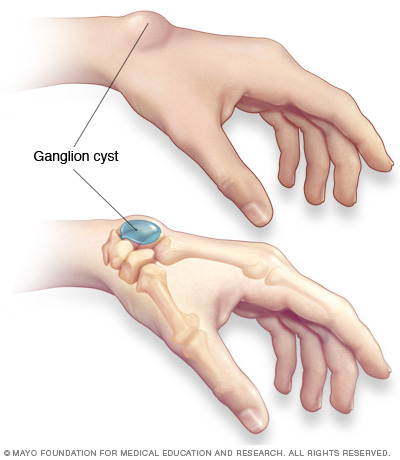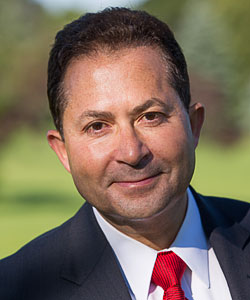Ganglion Cysts Palos Hills, Mokena and Chicago
Ganglion cysts are common benign (non-cancerous) tumors that appear in the hand and wrist adjacent to joints or tendons. Common locations are the top and bottom of the wrist, the base of the finger palm-side, and the top of the end joint of the finger palm-side.

Symptoms
A ganglion cyst rises out of a joint or tendon sheath and is filled with a clear fluid or gel, comparable to the fluid that lubricates joints throughout the body. Cysts are usually oval-shaped and range from soft to firm. They are not attached to the skin, but rather to the joint capsule or tendon sheath. Cysts may change in size and shape over time, while smaller cysts, referred to at “occult ganglions,” may remain hidden beneath the skin.
In some cases, these lumps grow larger with increased wrist activity and smaller with rest. If a ganglion cyst places pressure on surrounding nerves, this may result in pain, tingling, or muscle weakness. It is important to note that most ganglion cysts are harmless, will not spread elsewhere in the body. Ganglion Cysts can be treated non-operatively. However, if a ganglion cyst is particularly painful, impairs function or is unacceptable in appearance, surgical options are available.
Causes
The exact cause of ganglion cysts is unknown. Many experts speculate that they develop at the site of joint or tendon tissue degeneration caused by injury or trauma. This leads to a one-way valve allowing fluid into the cyst but not back into surrounding tissue.
Ganglion cysts appear most commonly in people between the ages of 15-40, most often affecting women. Cysts that develop at the end joint of a finger are referred to as "mucous cysts" and are typically linked to arthritis in the finger joint.

Diagnosis
A physician can usually diagnose a ganglion cyst after a patient describes their symptoms and are offered a physical examination, followed by an X-ray, ultrasound, or MRI to confirm the diagnosis.
Treatment
The majority of ganglion cysts do not require surgery. Physicians will normally recommend a regimen of nonsurgical treatments, such as:
- Observation - Being that ganglion cysts are noncancerous and may disappear over time, many physicians will simply suggest waiting and watching to ensure no further developments occur.
- Immobilization - Physicians often recommend the use of a splint or wrist brace to limit mobility and may prescribe NSAIDs such as acetaminophen or ibuprofen for pain management.
- Aspiration - If a cyst is particularly painful, the fluid may be drained from it -- a procedure known as “aspiration.” The area around the cyst is numbed, then the cyst is punctured by a needle that withdraws the fluid. This procedure commonly fails to solve the problem however, as ganglions act like weeds and grow back if the root remains intact.

Surgical Treatment
A physician may recommend surgery to remove the cyst if patient symptoms are not relieved through nonsurgical methods, or if the ganglion returns after aspiration. The procedure, referred to as "excision," is done on an outpatient basis and involves removing the cyst as well as part of the tendon sheath or joint capsule, commonly considered the "root" of the ganglion. Often the procedure can be done under local anesthesia. Post-surgery symptoms may include tenderness, discomfort and swelling, while most patients return to normal activity anywhere from 2-6 weeks after surgery.
For specialized care, turn to MidAmerica Orthopaedics Hand and Upper Extremity Surgeons, Dr. Gary A. Kronen and Dr. Anton J. Fakhouri.
Dr. Anton J. Fakhouri
Dr. Fakhouri is a board certified orthopaedic surgeon, specializing in treating trauma and fractures of the upper extremity, bone and soft tissue reconstruction, and microsurgical limb reconstruction.
He holds a special interest in the treatment of carpal tunnel syndrome, tendonitis, arthroplasty of the fingers, and arthritis of the hand, wrist and elbow.

Dr. Gary A. Kronen
Dr. Kronen’s expertise lies in treating common conditions of the hand and upper extremity including carpal tunnel syndrome, trigger finger, arthritis, tendonitis and excision.
He has been recognized by "The Leading Physicians of of the World" and America’s Top Surgeons as being one of the Premier Hand Surgeons in the United States.

To learn more about MidAmerica Orthopaedics and the different treatment options available to you, visit our website.
To schedule an appointment with MidAmerica Orthopaedics Hand and Upper Extremity Surgeon, Dr. Gary A. Kronen, call (708) 237-7200.

